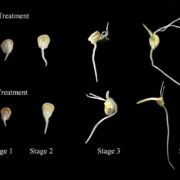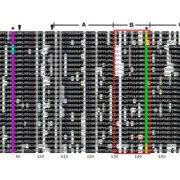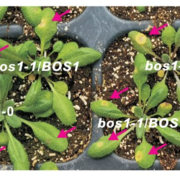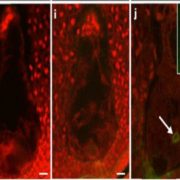Moonlighting activities and control of meristem maintenance in maize ($) (Nature Plants)
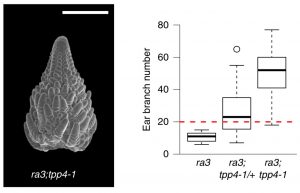 The phosphorylated disaccharide trehalose 6-phosphate (T6P) is a regulator of meristem fate. Mutations in enzymes related to T6P metabolism (such as TPS, the synthase, or the phosphatase trehalose 6-phosphate phosphatase TPP, i.e., RAMOSA3 that dephosphorylates T6P to trehalose), are linked to defects in reproductive development in maize. For instance the ramosa3 (ra3) mutant has increased tassel branching and ectopic branching in ears, due to reduced meristem determinacy. To better understand the role of TPP in the regulation of meristem determinacy, Claeys et al, identified TREHALOSE 6-PHOSPHATE PHOSPHATASE 4 (TPP4), a fully redundant paralogue of RA3. The T6P disaccharide levels are similar in the ra3, the ra3;tpp4-1 double mutant and the B73 wild type, so the authors speculate TPP4 enzymatic activity may not be important for the roles of those phosphsatases in meristem maintenance. Their EMS-generated tpp4 alleles were affected in ear branching, but the enzymatic activity of the different encoded TPP versions varied from 0 to 35% compared to the wild type. Additionally, the ra3 mutant could be complemented by a catalytically dead RA3. All these findings suggest a non-enzymatic function as responsible for the role of TPP in the control of meristem determinacy. The localization of RA3 in some nuclear compartments suggests a role in the regulation of RNA processing and transcription. Precise control of meristem activity, through these genes, could lead to higher yields in maize and other crops. (Summary by Humberto Herrera-Ubaldo) Nature Plants 10.1038/s41477-019-0394-z
The phosphorylated disaccharide trehalose 6-phosphate (T6P) is a regulator of meristem fate. Mutations in enzymes related to T6P metabolism (such as TPS, the synthase, or the phosphatase trehalose 6-phosphate phosphatase TPP, i.e., RAMOSA3 that dephosphorylates T6P to trehalose), are linked to defects in reproductive development in maize. For instance the ramosa3 (ra3) mutant has increased tassel branching and ectopic branching in ears, due to reduced meristem determinacy. To better understand the role of TPP in the regulation of meristem determinacy, Claeys et al, identified TREHALOSE 6-PHOSPHATE PHOSPHATASE 4 (TPP4), a fully redundant paralogue of RA3. The T6P disaccharide levels are similar in the ra3, the ra3;tpp4-1 double mutant and the B73 wild type, so the authors speculate TPP4 enzymatic activity may not be important for the roles of those phosphsatases in meristem maintenance. Their EMS-generated tpp4 alleles were affected in ear branching, but the enzymatic activity of the different encoded TPP versions varied from 0 to 35% compared to the wild type. Additionally, the ra3 mutant could be complemented by a catalytically dead RA3. All these findings suggest a non-enzymatic function as responsible for the role of TPP in the control of meristem determinacy. The localization of RA3 in some nuclear compartments suggests a role in the regulation of RNA processing and transcription. Precise control of meristem activity, through these genes, could lead to higher yields in maize and other crops. (Summary by Humberto Herrera-Ubaldo) Nature Plants 10.1038/s41477-019-0394-z


